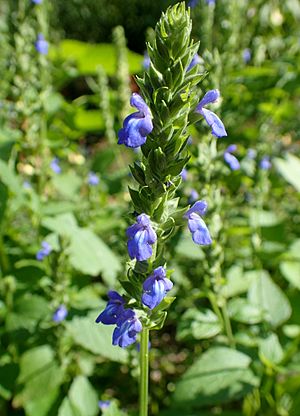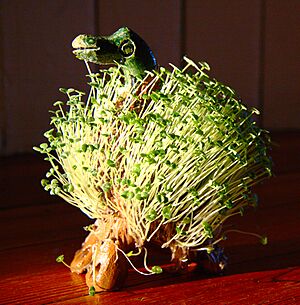Salvia hispanica facts for kids
Quick facts for kids Salvia hispanica |
|
|---|---|
 |
|
| Scientific classification | |
| Genus: |
Salvia
|
| Species: |
hispanica
|
| Synonyms | |
|
|
Salvia hispanica, often called chia, is a type of flowering plant in the mint family. It comes from central and southern Mexico and Guatemala. Chia is known as a pseudocereal, which means it's used like a grain but isn't a true grain. People grow it for its edible chia seeds. These seeds are special because they are hydrophilic, meaning they love water and soak up a lot of it. Chia seeds are a common food in parts of South America, Mexico, and the southwestern United States.
Contents
What Does "Chia" Mean?
The word "chia" comes from the Nahuatl language, spoken by the Aztec people. The Nahuatl word chian means "oily."
Salvia hispanica is one of two plants called "chia." The other is Salvia columbariae, sometimes known as "golden chia."
About the Chia Plant
Chia is an annual herb, which means it lives for only one growing season. It can grow up to about 5.7 feet (1.75 meters) tall. Its leaves grow opposite each other on the stem. They are usually 1.5 to 3 inches (4 to 8 cm) long and 1 to 2 inches (3 to 5 cm) wide.
The flowers of the chia plant can be purple or white. They grow in many clusters on a spike at the end of each stem. Chia plants can grow well in warm climates, like those in USDA Zones 9–12. It's important to know that some plants grown as Salvia hispanica are actually Salvia lavandulifolia.
Chia Seeds: Small but Mighty
Chia seeds are small and oval-shaped, about 0.04 inches (1 mm) across. They have different colors like brown, gray, black, and white. These seeds are very good at absorbing water. They can soak up to 12 times their own weight in liquid! When they soak, they get a mucilaginous (jelly-like) coating. This coating gives drinks made with chia a unique gel-like texture.
Chia is mostly known as Salvia hispanica or Salvia columbariae. People grow and sell chia in its native Mexico and Guatemala. It's also grown in Bolivia, Ecuador, Colombia, Nicaragua, Argentina, parts of Australia, and the southwestern United States. New types of chia have been developed in Kentucky. These new types can grow in cooler northern parts of the United States.
Chia Seeds: What's Inside?
| Nutritional value per 100 g (3.5 oz) | |
|---|---|
| Energy | 486 kcal (2,030 kJ) |
|
42.12 g
|
|
| Dietary fiber | 34.4 g |
|
30.74 g
|
|
| Saturated | 3.330 |
| Trans | 0.140 g |
| Monounsaturated | 2.309 |
| Polyunsaturated
omega‑6
|
23.665
17.830 g
5.835 g
|
|
Protein
|
16.54 g
|
| Vitamins | Quantity
%DV†
|
| Vitamin A equiv. |
7%
54 μg |
| Thiamine (B1) |
54%
0.62 mg |
| Riboflavin (B2) |
14%
0.17 mg |
| Niacin (B3) |
55%
8.83 mg |
| Folate (B9) |
12%
49 μg |
| Vitamin C |
2%
1.6 mg |
| Vitamin E |
3%
0.5 mg |
| Minerals | Quantity
%DV†
|
| Calcium |
63%
631 mg |
| Iron |
59%
7.72 mg |
| Magnesium |
94%
335 mg |
| Manganese |
130%
2.723 mg |
| Phosphorus |
123%
860 mg |
| Potassium |
14%
407 mg |
| Sodium |
1%
16 mg |
| Zinc |
48%
4.58 mg |
| Other constituents | Quantity |
| Water | 5.80 g |
| Cholesterol | 0 mg |
|
Full Link to USDA Database entry
|
|
| †Percentages estimated using US recommendations for adults. | |
Chia is grown for its seeds, which are a great food source. They are rich in omega-3 fatty acids. These seeds can give 25–30% of their weight in oil. This oil includes a lot of alpha-linolenic acid. About 55% of the oil's fat is omega-3, 18% is omega-6, 6% is omega-9, and 10% is saturated fat.
How Chia is Grown
Growing Climate and Time
The time it takes for chia to grow varies depending on where it's planted and how high up it is. In Bolivia, Ecuador, and Argentina, chia takes between 100 and 150 days to grow from planting to harvest. Because of this, commercial chia farms are found at different heights, from 26 feet (8 meters) to 7,200 feet (2,200 meters) above sea level. They grow in many different environments, like tropical deserts, rainforests, and dry valleys in the Andes mountains. In northwestern Argentina, it takes 120–180 days to grow chia at heights of 2,950–4,920 feet (900–1,500 meters).
Salvia hispanica is a "short-day" plant. This means it flowers when the days are shorter. This has limited where chia seeds could be grown commercially to tropical and subtropical areas until recently. However, new types of chia plants have been developed. These can now grow in temperate areas, which are cooler zones at higher latitudes in the United States. For example, in Arizona and Kentucky, traditional chia plants would stop growing because of frost before or after flowering. But in 2012, new early-flowering chia types were created. These new types produce more seeds in places like Kentucky.
How Many Seeds and What's in Them?
The amount of seeds a chia plant produces changes. It depends on the type of plant, how it's grown, and the growing conditions in different places. For example, commercial farms in Argentina and Colombia can produce between 400 and 1,100 pounds per acre (450 to 1,250 kg/ha). A small study in Ecuador showed yields up to 2,050 pounds per acre (2,300 kg/ha). This suggests that good growing conditions and the right plant type can lead to high yields. The type of chia plant has a bigger effect on how many seeds are produced than on the amount of protein, oil, or other compounds in the seeds. High temperatures can reduce the oil content and make the oil less healthy, but they can increase the protein content.
Soil and Planting Needs
Chia plants grow best in light to medium clay or sandy soils. They prefer soils that drain water well and are moderately fertile. However, they can also grow in acidic soils and handle some dry periods. When chia seeds are first planted, they need moisture to start growing. But once the plant is bigger, it doesn't like wet soils.
Old ways of growing Salvia hispanica included preparing the soil by breaking it up and loosening it. Then, the seeds were scattered. In modern farming, farmers usually plant about 5.4 pounds per acre (6 kg/ha) of seeds. They plant them in rows that are about 2.3 to 2.6 feet (0.7 to 0.8 meters) apart.
Feeding and Watering the Plants
Salvia hispanica can grow with only a small amount of fertilizer. Sometimes, farmers use about 90 pounds per acre (100 kg/ha) of nitrogen, or even no fertilizer at all.
How often chia fields need water depends on the weather and how much it rains. Some fields might not need any extra water, while others might need watering up to eight times during the growing season.
Different Types of Chia and Breeding
There are many different types of wild and farmed Salvia hispanica. They vary in seed size, how easily their seeds fall off the plant (called shattering), and seed color. The weight and color of the seeds are strongly passed down from parent plants. A single recessive gene is responsible for the white seed color.
Plant Health and Care
Right now, there are no major bugs or diseases that cause big problems for chia crops. The essential oils in chia leaves can actually keep insects away. This makes chia a good plant for organic farming. However, viruses, possibly carried by white flies, can sometimes infect the plants. Weeds can be a problem when chia plants are young, before their leaves grow thick enough to cover the ground. Since chia is sensitive to most common herbicides, farmers prefer to remove weeds by hand or with machines.
Chia for Fun and Decoration
In the 1980s in the United States, chia seeds became popular because of Chia Pets. These "pets" are clay figures that you cover with a sticky paste of chia seeds. You water the figures, and the seeds sprout. The sprouts look like fur covering the figure. About 500,000 Chia Pets are sold each year in the U.S. as fun novelty items or house plants.
See also
 In Spanish: Chía para niños
In Spanish: Chía para niños



